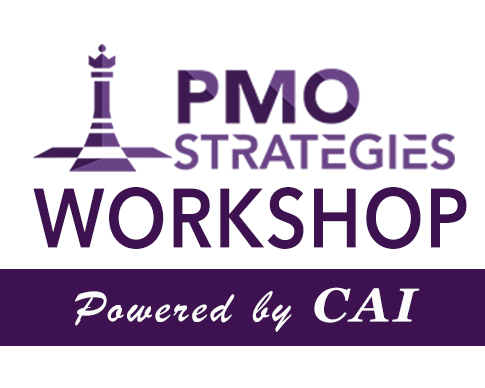 This week we are highlighting another one of our brilliant minds in the PMO space that is joining us for our roll up your sleeves PMO workshop on April 4, 2019.
This week we are highlighting another one of our brilliant minds in the PMO space that is joining us for our roll up your sleeves PMO workshop on April 4, 2019.
In the last few years talk about portfolio management has increased significantly. It seems as though every organization has at least considered implementing it, is planning an implementation or has already started applying the principles in one form or another. That’s a positive evolution in how organizations approach strategic planning and the execution of that strategy, but it’s not all good news.
Ownership of portfolio management has varied considerably, and sometimes the function or individual accountable for portfolio management is the very reason why it hasn’t succeeded. I believe there’s a simple solution to that – give it to the PMO. Here are the top five reasons why.
- Portfolio management is a critical discipline for organizations today
If you are involved in projects then you are involved in portfolio management. Portfolio management is increasingly being viewed by executives as the strategy execution arm of the organization. At the start of portfolio management is the establishment of an organization’s goals and objectives and the creation of the annual strategic plan. At the other end of the portfolio is the achievement of business benefits that align with those goals and objectives. Everything in between is portfolio management.
Deciding which projects will be approved as part of the portfolio, prioritizing those initiatives, resourcing them and monitoring progress during project execution all falls under portfolio management. So too does the adjustment of those projects based on any number of different factors – project performance issues, shifting priorities, a changing operating environment, etc. All of those impact the organization’s ability to deliver on its goals and potentially require changes in the way strategy is executed. That requires effective portfolio management.
For project managers and teams, knowing how their initiative contributes to the organization’s success is critical if they are to make the right decisions in execution. It’s no longer good enough to deliver on time, on scope and on budget – if the project doesn’t achieve the required business results it has still failed. Instead, the focus must be on delivering projects ‘on benefit’ – achieving the desired business outcomes through project outputs. That’s a very different mindset for project managers and it’s a mindset that aligns with the portfolio management perspective. If PMs don’t understand portfolio management concepts and how those concepts are applied in their organization, they will be unable to do as good a job as they need to – and that’s a problem!
So, if portfolio management is strategy execution (and it is), and if PMs are the individuals who own the initiatives that deliver portfolio goals (and they are), the PMO is the logical place for portfolio management to live. No other function can connect strategy with delivery as effectively or efficiently.
- Organizations aren’t very good at portfolio management
Portfolio management as a concept has been around for some time, but the bottom line is that not many organizations do it well. There are a number of reasons for that, but one of the biggest is that they fail to view portfolio management as an integrated, end to end approach. Portfolio management starts with the generation and capture of ideas and ends with the achievement of benefits. It encompasses executive level planning and frontline project execution. It spans multiple business units and requires the support of IT, Finance, HR and all other general management functions. In short, it’s an enterprise-wide approach. Yet for many organizations it’s viewed as a bolt-on process that sits on top of project delivery. Instead of focusing on the best possible outcomes, those organizations focus on the least possible disruption. Of course, those same organizations wonder why they haven’t seen tremendous improvements in performance since they implemented portfolio management!
To truly embrace and leverage portfolio management effectively you have to understand it. You have to appreciate how it supports the business, how it integrates with planning and delivery, and how it supports the alignment of every aspect of strategy from the development of the initial goals to the achievement of the final objective. If any one of those pieces is missing the ability to optimize performance is restricted – and that means you are leaving money on the table (which your competitors will happily take advantage of).
With that understanding comes the ability to align all strategic processes in the organization to achieve the best possible outcomes. Instead of trying to force portfolio management to align with the annual planning processes that have changed little in decades, or with the funding models that were designed to make financial reporting easier, those approaches (and more) are all adjusted to create a seamless, integrated approach that allows the organization to succeed and thrive in today’s modern business environment.
Project management is already evolving to support modern ways of working – Agile and hybrid are evidence of that, and successful PMOs are adapting to embrace those approaches alongside traditional waterfall approaches. The PMO is a logical body to ask to help modernize planning as an extension of that evolution, and that is exactly what portfolio management needs.
- In a fast-paced world, portfolio management is the gas pedal
In virtually every industry, things are speeding up. Technology is breaking down barriers to entry for competitors and redefining what is possible on a regular basis. Customers have shorter satisfaction windows, demanding more capability more quickly than ever before, and demonstrating far less loyalty if they don’t get it. This makes it far harder for organizations to plan multiple quarters in advance. Annual planning may still take place, but any expectation that the projects approved for delivery in the 4th quarter of next year will still be relevant by the time that 4th quarter comes around is optimistic at best.
As a result, organizations are having to embrace the concept of adaptive planning. That still allows them to set annual investment budgets, and may even allow them to conduct high level project planning for the full year, but the expectation must be that those plans will evolve in response to changes in the operating environment. During the annual cycle, the ability to deliver results will be impacted by the actions of competitors, shifting customer demands, technological innovations and any number of other factors from regulatory changes to supplier innovations.
All of those factors impact not just the ability of the organization to achieve the goals and objectives that have been set, but also those goals and objectives themselves. There may be a need to change some of the targets or even replace one or more goals, and of course any change in the strategy requires a change in the execution of that strategy – and that’s where portfolio management comes in. Portfolio management must maintain alignment between what the organization needs – the goals and objectives, and what it is getting – the business outcomes enabled by the projects and programs that make up the portfolio. When there are changes in what is required, or when the actual benefits being achieved are different to those expected, the portfolio must be adjusted to maintain alignment.
That may mean cancelling projects and initiating replacements, it may be making changes to existing projects, shifting the scheduling or any number of other adjustments. Regardless of the mechanics of the changes, portfolio management requires continuous adaptive planning to occur – constant rebalancing of the work being done to ensure optimal business performance. The portfolio manager has to constantly ‘feather the gas pedal’ of the business to ensure the organization is delivering results as quickly as possible without losing control of what’s happening.
If that isn’t aligned with the role of PMOs to ensure project execution is as effective and efficient as possible, I don’t know what is!
- You can’t lead by looking backwards
In most organizations the review of project progress is an exercise in looking in the rear-view mirror. It’s focused on reports and dashboards that show what has already happened. That doesn’t do much to help ensure the organization gets to where it needs to be. To achieve that we need to understand not where we have been, but where we are going – looking through the windshield with only an occasional glance in the rear-view. That’s what portfolio management helps to deliver.
Portfolio management focuses attention on business outcomes, not project outputs. It is therefore necessarily further forward looking than most project management and reporting, seeking to understand what will happen when the project’s deliverables are absorbed into business operations and are actually driving changes in how the organization operates. Portfolio management helps to identify and understand problems earlier, giving the business more time to take corrective action. It also helps the organization better understand what kind of actions are necessary, improving the chances of implementing the right adjustments.
This has benefits in all areas of project delivery. Project teams operating in a portfolio environment are better able to understand how their actions will impact the business, and that allows them to identify problems earlier. That in turn enables faster and less disruptive solutions, reducing the impact on the project and improving the likelihood of success. For department heads and executives, the earlier identification of variances from expectations provides a broader set of options to correct the situation and protect overall organizational performance. A forward-looking portfolio management approach also provides a cohesive picture of everything that is happening in the portfolio – allowing for decisions to be taken with consideration for all the impacts, not just the narrow focus of an individual problem.
This is where PMOs can excel, as long as they are modern, business focused PMOs that recognize the importance of driving an outcome-based future rather than managing an output driven past.
- In project planning, the portfolio comes first
Or at least it should. Too many organizations approve a list of projects and then create a portfolio management framework around those projects. That’s a completely illogical approach and it has real impact on performance. Think about the other context where we talk about portfolios – investments. When we sit down with our financial planner to review our 401(k), RRSP, personal pension plan or whatever investment vehicle we have for retirement savings in our jurisdiction, we focus on the performance of the portfolio of investments we have. There may be a conversation about a particular stock, bond or fund but the focus is always on the overall return – those stocks and bonds are temporary members of the long-term portfolio that contribute to the overall goals. When they can no longer contribute, they are replaced.
That’s how we need to look at project portfolios. Create the portfolio as the vehicle to deliver a return on investment – in this case achieving the goals and objectives the organization has set, and recognize the need to move projects in and out based on their ability to contribute to those goals. If projects are no longer able to deliver what is needed, they are cancelled and replaced – and that’s OK because it is what is needed for the good of the portfolio. If instead we focus on the projects, as too many organizations do, we lose sight of the bigger picture – that project outputs are far less important than business outcomes.
This is the heart of portfolio management and the heart of the modern PMO. Enabling business success through projects while recognizing that, individually, those projects are far less important than the portfolio.







